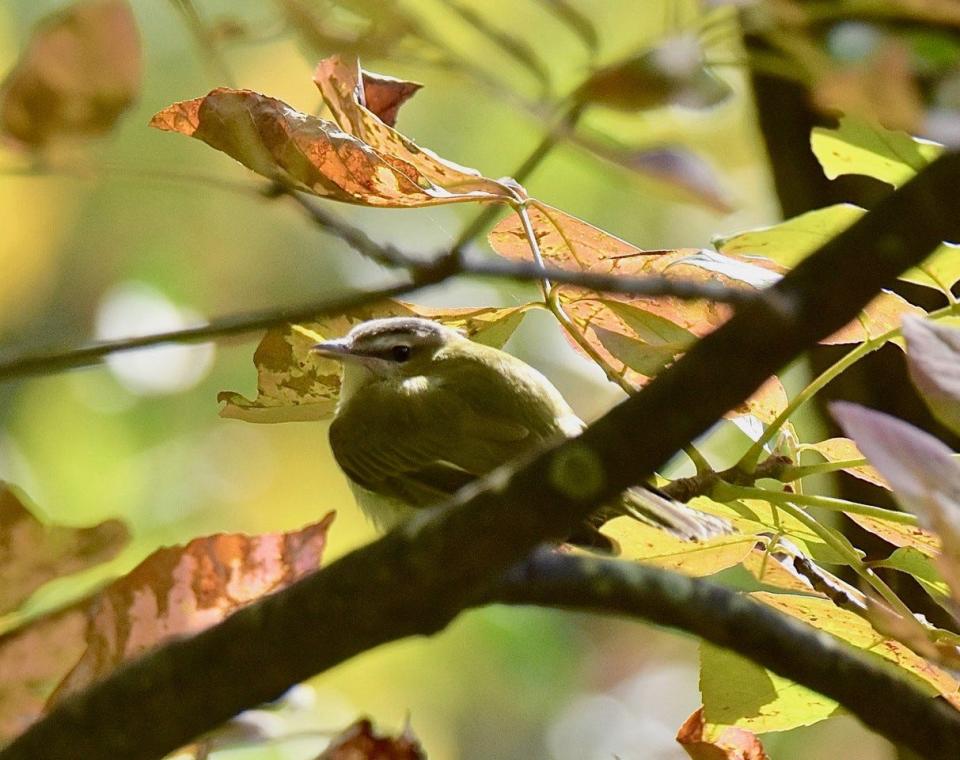Is it a red-eyed vireo? A Philadelphia? Identifying birds is more complex than you think
Yours truly encountered a little brown job on the driveway. He didn’t know quite what it was.
LBJs, as they're called, have a way of inflicting uncertainty. They are little brown birds, devoid of bright markings, so drab birders often will see one and look in another direction.
Not this birder. I saw it, moved toward it and went through my little brown checklist.

Season? Late September. Migration time for many songbirds.
Habitat? Woods bordered by a brushy clearing.
Size? Bigger than a warbler; smaller than a robin.
Behavior? Slowly combing tree branches, hunting caterpillars.
Conclusion: It’s a vireo. I’ve seen thousands. I know how big they are, their shape and how they forage for food: more slowly and deliberately than warblers.
But what kind of vireo? Ah, the rub.
More: An uncommon sight: Great horned owl makes daytime visit
The bird did feature a field mark or two. One was a black line from the base of the bill to the eye. Another was a splash of white above and below that line.
Remember the season. If this were June, I would have only one vireo with a line through its eye to choose from. The red-eyed is the only vireo nesting in my forest. But during migration season, other options pop up, including the illusive Philadelphia vireo.
I wanted this bird to be a Philadelphia. I’ve seen a handful in a lifetime of birding.
I haven’t mentioned I was packing a camera. I took photos, some of them decent. The bird hung around for a minute before melting away through thick leaves.
More: With fall's arrival, this month marks 'a blink of the seasonal eye' in nature
Back home, I looked at hundreds of vireo photos in books and online. These included photos of red-eyed vireo juveniles, which don’t have red eyes (the bird I saw did not), warbling vireos, which often are mistaken for Philadelphias, and Philadelphias themselves.
I looked at migration patterns: when each of these birds passes through my Northeastern domain.
I sent one photo to Cornell’s Merlin app, which can identify photos it receives. It came back suggesting either red-eyed or Philadelphia vireo.
That’s when I just said “enough.” I can’t identify this bird with certainty.
It’s all right to do that: to say you don’t know.
In a lifetime of leading bird walks and answering questions about bird identification, I have said it many times.
That doesn’t make it easy. Experienced birders face pressure to be all-knowing. A bird pops out on a walk I am leading. I’m expected to know it at once. But that’s impossible sometimes. The light might be poor or the view compromised. Or the bird simply defies easy identification.
Faced with these uncertainties, it’s easy for the “bird pro” to pick a most likely bird and announce it with authoritative tones. Those with him go home none the wiser.
But with age comes the realization that the mark of an expert and good teacher is knowing, through painful experience, when to say I don’t know.
I marked the bird down as a vireo and left it at that.
E-mail Rick at rmarsi@stny.rr.com.
This article originally appeared on Binghamton Press & Sun-Bulletin: Why an instant, precise bird ID is a tall order, even for Merlin

